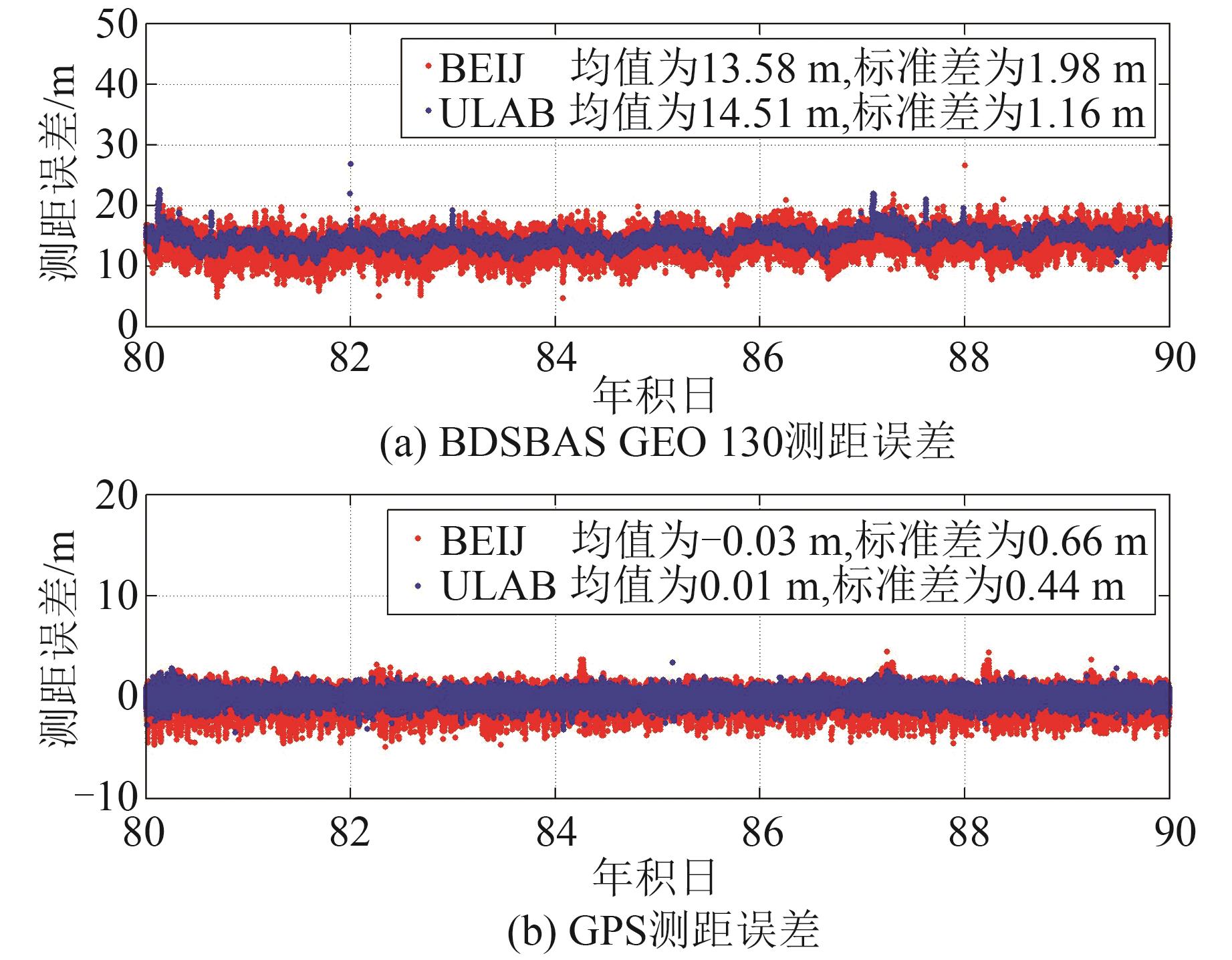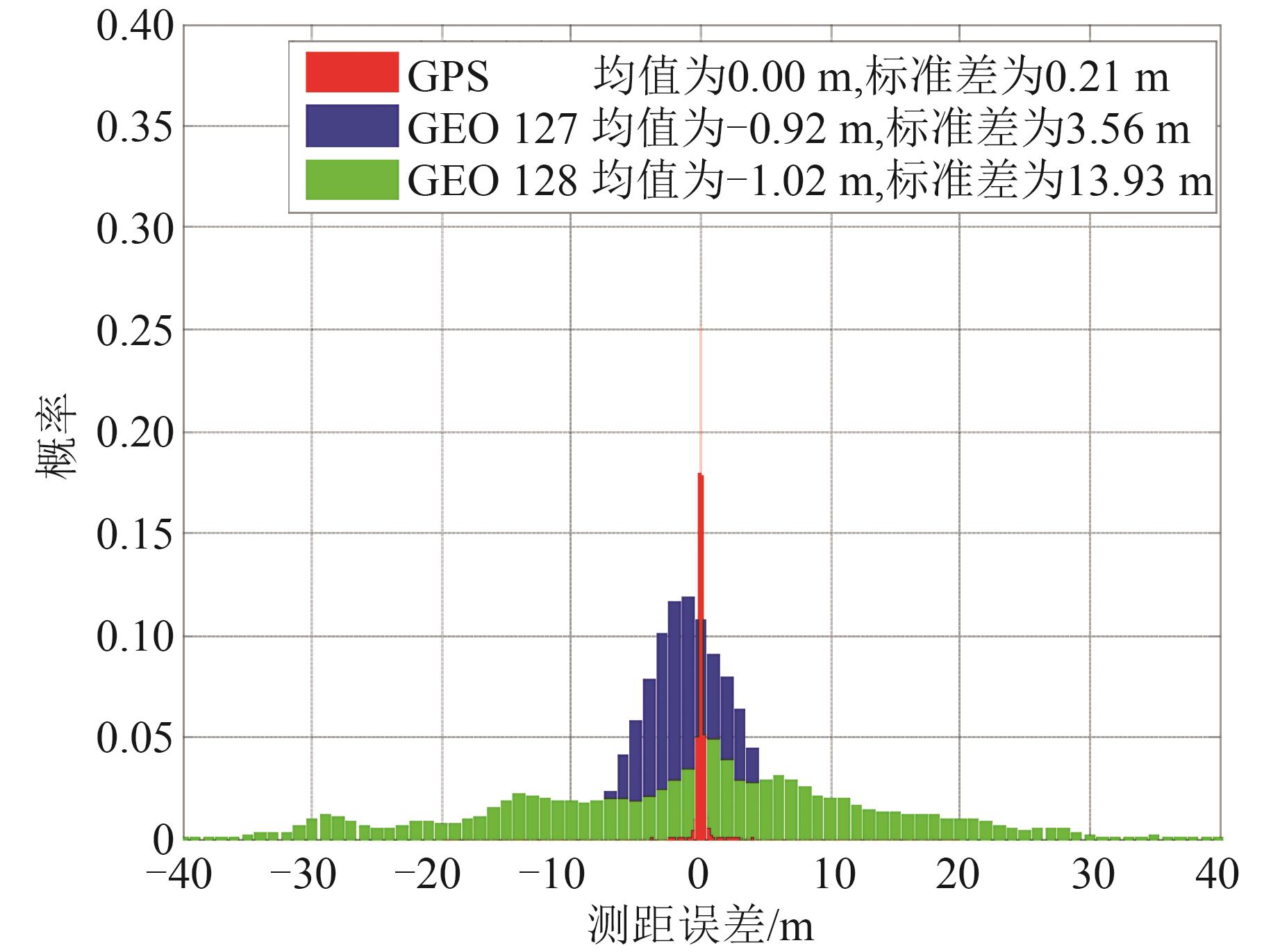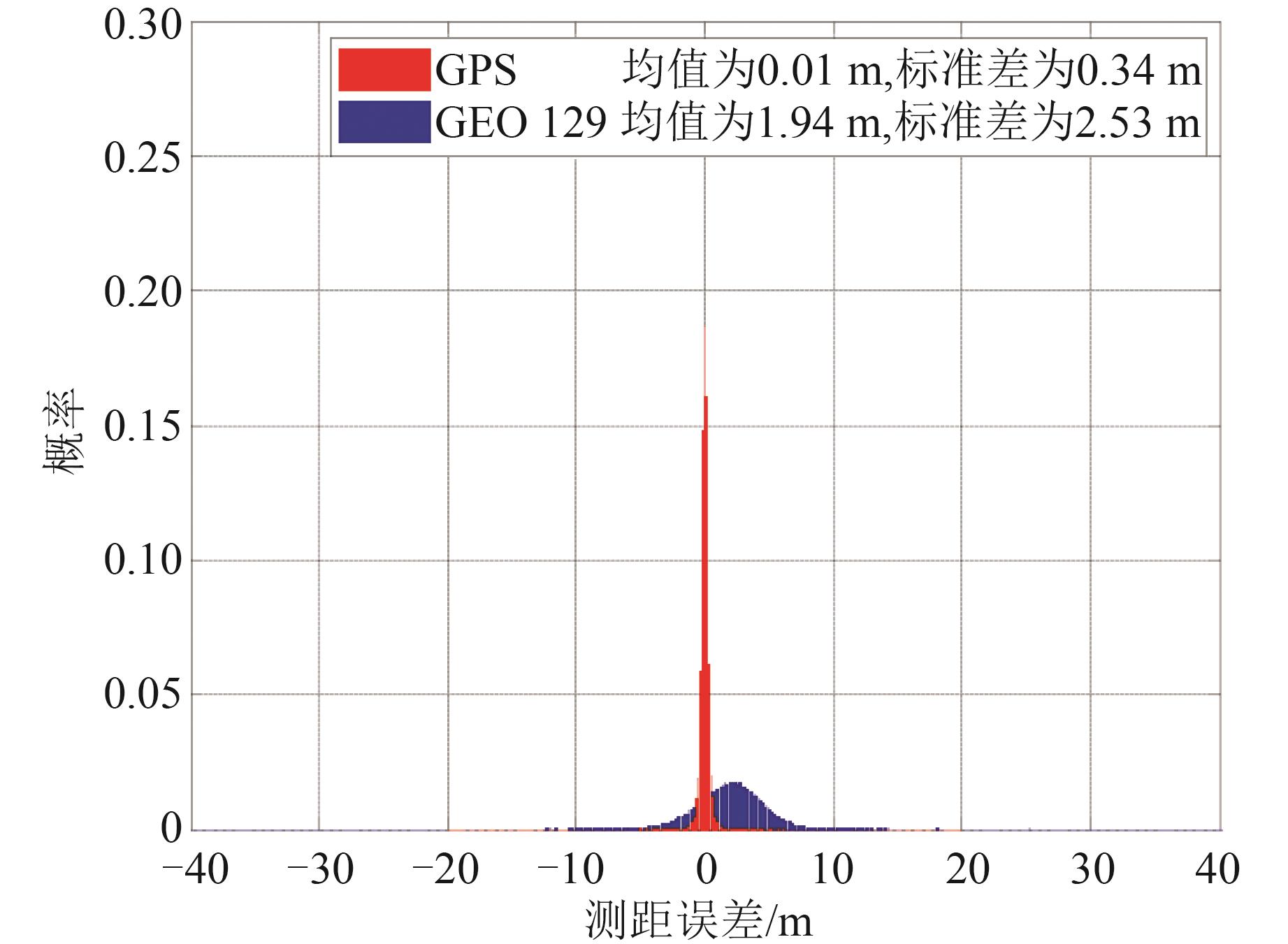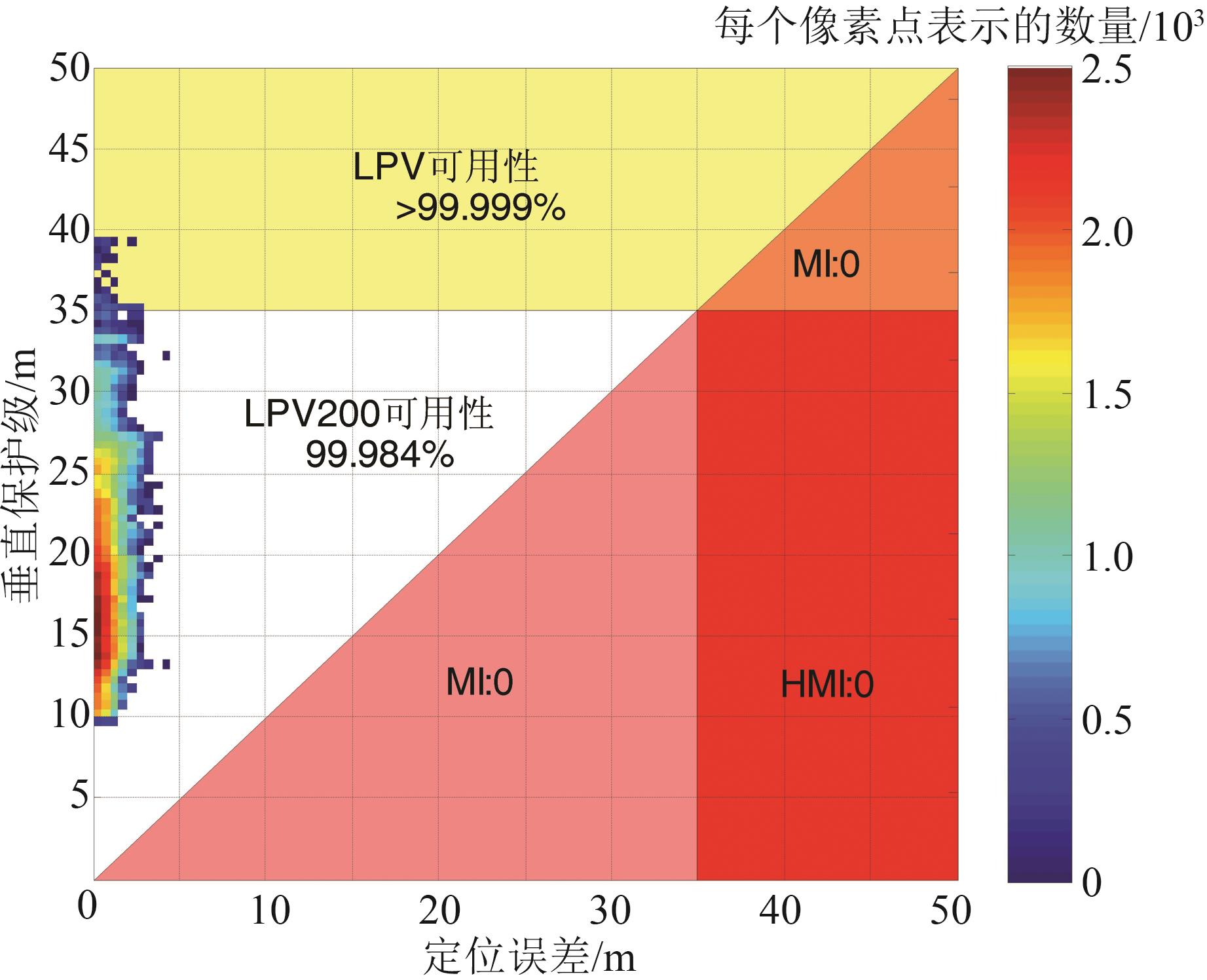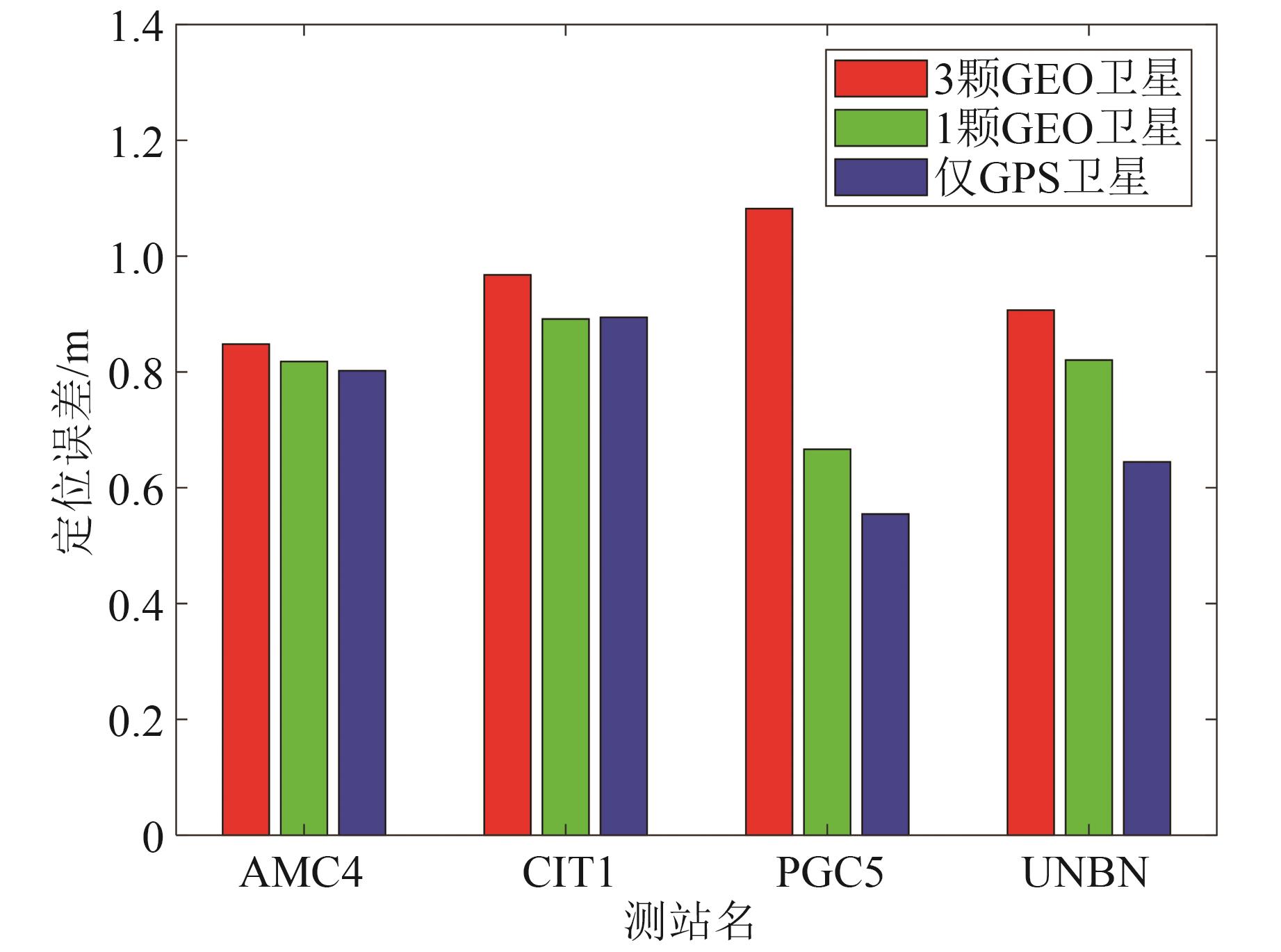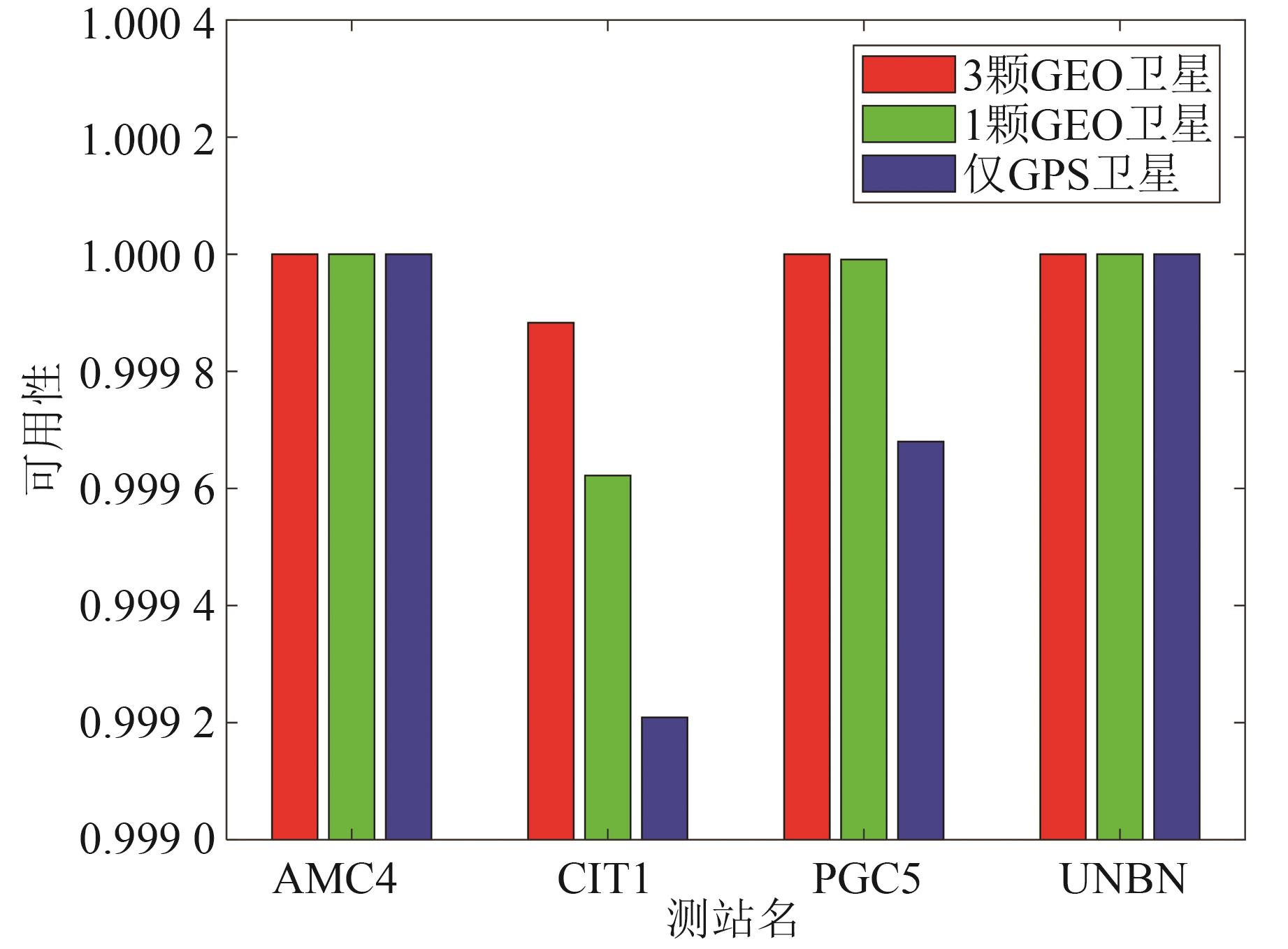SBAS GEO Satellite User Range Error and Position Augmentation Research
-
摘要:
分析星基增强系统(satellite based augmentation system,SBAS)地球同步轨道(geostationary Earth orbit,GEO)卫星用户测距误差(user range error,URE),研究GEO卫星测距对导航定位性能的影响,可为SBAS系统设计和民航应用提供有益参考。利用广域增强系统(wide area augmentation system,WAAS)、北斗星基增强系统(BeiDou SBAS, BDSBAS)、GPS辅助静地增强导航系统(GPS aided GEO augmented navigation, GAGAN)和多功能卫星增强系统(multi-functional satellite augmentation system,MSAS)的SBAS信息对GPS和GEO卫星星历、时钟和观测值进行改正,固定测站位置,根据改正数残差方差加权计算接收机钟差,得到GEO卫星测距误差;将GEO卫星观测值纳入SBAS定位解算,评估GEO卫星测距对定位结果的影响。通过实测数据分析可知,WAAS GEO卫星URE优于1.6 m;BDSBAS 3颗GEO卫星分别存在14.32 m、12.64 m和17.44 m的系统偏差,经系统性误差改正后,GEO卫星URE优于2.9 m;GAGAN和MSAS GEO卫星URE分别优于13.9 m和3.2 m。当GPS卫星数较少时,联合GEO卫星观测值进行SBAS解算能够有效减小定位保护级,提升系统可用性。
Abstract:ObjectivesSatellite based augmentation system (SBAS) improves the positioning accuracy and integrity by broadcasting ephemeris corrections and associated integrity parameters through geostationary Earth orbit (GEO) satellites. SBAS GEO satellite can also be used as a ranging source together with GPS satellites to improve the system performance. User range error (URE) of the GEO satellite and their effect on positioning results are investigated. URE of SBAS GEO and GPS satellite is determined by weighting the observation residuals which are derived with fixed station coordinates. SBAS messages are applied to correct the orbit and clock errors contained in broadcast ephemeris and the ionosphere delay. Ranging data from GEO satellite is engaged in the SBAS positioning process to explore the impact on positioning accuracy, integrity and availability.
MethodsSBAS messages broadcast by wide area augmentation system (WAAS), BeiDou SBAS (BDSBAS), GPS aided GEO augmented navigation (GAGAN) and multi-functional satellite augmentation system (MSAS) and real data from international GNSS service (IGS) stations are applied to perform the assessment. European geostationary navigation overlay service (EGNOS) and system for differential corrections and monitoring (SDCM) are not included because of the absence of the ranging capability.
ResultsWAAS GEO satellite has the best performance with ranging accuracy better than 1.6 m. The 99.9% error bound is less than 6.8 m while the broadcast user differential range error (UDRE) for the GEO satellite is 7.5 m, which meets the integrity requirement. The 3 GEO satellites of BDSBAS show ranging biases of 14.32 m, 12.64 m and 17.44 m respectively, and the accuracy is better than 2.9 m. After removing the bias, the related 99.9% error bound is 8.60 m, 7.80 m and 11.60 m which suggests an UDRE of 11-12. User range accuracy (URA) of 15 is broadcast in message type 9 for the BDSBAS GEO satellites. URE of the GAGAN GEO satellite is better than 13.9 m and MSAS is better than 3.2 m. The UDRE of GAGAN and MSAS is 14. URE of GPS satellite after augmented by SBAS is also calculated for comparison purpose. Ranging accuracy of GPS is 0.60 m, 0.53 m, 0.21 m and 0.34 m for WAAS, BDSBAS, GAGAN and MSAS respectively. WAAS GEO satellite is selected to perform the positioning analysis whose UDRE is less than 14 so that it can be weighted properly in the solution. Engagement of GEO satellite in SBAS positioning will lead to lower position dilution of precision (PDOP) and reduce the protection level especially for the blockage circumstance. The system availability of localizer performance with vertical guidance 200 (LPV200) service is improved from 99.984% to 99.997% with collaboration of 3 GEO satellites' observation.
ConclusionsWith sufficient GPS satellites, the combination of GEO satellites will decrease the positioning accuracy because of the relative larger range error, while with less available satellites, combining the GEO satellite data effectively reduces the protection level and improves the system availability. Results suggest that SBAS GEO ranging data should be included in the SBAS solution for aviation users.
-
Keywords:
- SBAS /
- GEO satellite /
- URE /
- position augmentation
-
纵观城市形成的历史进程,道路网作为一种公共框架约束着城市形态和人类行为。作为城市系统的子系统,道路网被认为是城市的“指纹”[1],路网模式反映了城市道路的分布特点,影响着城市的结构和组织,蕴含着大量城市形成和演变的内在机制。由于城市系统本身的复杂性,路网模式在不同的领域都有不同的分类体系[2]。从研究载体上来看,路网模式识别方法可以分为基于面(网眼)的和基于线的识别方法。
Heinzle等[3-4]基于图论对路网模式进行了系列研究,通过网眼中心的排列来识别网格模式;利用统计指标(Tukey深度值)和形态指标(仿射不变量)识别环状模式。田晶等[5-6]结合机器学习算法识别网格模式。Yang等[7]结合形态学指标和多指标评价提出了一种探测和量化网格模式的方法。Louf等[1]通过计算所有网眼的几何和拓扑信息得到城市的类型分布图来区分不同的城市。基于网眼的识别方法,以一种全局的观点将网眼作为抽象采样点对其进行统计描述,而忽略网眼内部的道路弧段的几何和拓扑特征。在构建网眼时也会丢失部分弧段的链接信息。
Heinzle等[3]通过霍夫变换识别直线,相交识别网格模式。Heinzle等[8]通过Dijkstra算法探测延伸道路识别放射模式。Porta等[9]将空间句法理论及中心度量度结合分析城市路网拓扑模式,并得出网格模式在城市中是普遍存在的结论。Xie等[10]对路网构图,借助信息熵的概念来区别不同结构的道路网络。Jiang等[11-13]利用空间句法和复杂网络等理论研究和定义了城市的拓扑结构。基于线的识别方法,直接以道路弧段作为基本单元,着眼于线性扩展和局部的图形结构分析,而缺少全局的上下文环境分析,例如相邻区域内的弧段拓扑结构、节点分布统计特征和相邻区域边的排列组织等。
根据格式塔认知原则,首先将目标作为一个整体获得完整的模式,继而对组成目标的细节进行分析[14]。基于面的方法用一种全局观念,以统计分析的方法进行模式识别;而基于线的方法以一种局部的图形结构分析实现模式探测。本文尝试将这两种方法中的有益思想综合,先给出一种图结构上的场模型,在线性结构上实施统计分析,然后以局部结构的特征分析实现网格模式识别。
1 网络空间栅格化
使用形态单一的线性栅格单元剖分网络空间已成为基于网络环境的空间分析的重要方法[15-18]。本文将此思想引入到路网模式识别中。定义道路交叉点和不同等级道路的分界点等特征点为网络节点,利用节点分割道路生成道路弧段,将道路网的每一条弧段都用相同的栅格单元进行剖分,构造节点-弧段、栅格单元-栅格单元和节点-栅格单元拓扑关系,建立网络剖分数据结构。
剖分粒度的细化对应着算法时间复杂度的增长[19],适当的剖分粒度取决于应用环境及路网弧段的长度。Ai等[15]提出剖分粒度可以参考网络边的平均长度设定,网络边的平均长度越大,剖分粒度越大;She等[16]使用平均长度对道路网络进行剖分并证明其合理性,并指出由于实际路网中可能存在小于设定的剖分粒度的边,最终得到的剖分结构并不是严格相等的。本文将参考此方案进行网络空间栅格化剖分粒度的确定。
本文将道路网视为嵌在2D空间中的独立空间,如图 1所示,在对象空间将道路网络空间剖分成连续分布的线性栅格单元组成的场模型。对原始数据的矢量运算转换成叠置、扩展及关系探测等地图代数运算。将模式定义为相邻栅格单元或相邻区域特征值上相互关系的表征。通过计算栅格单元邻域的拓扑和几何特征,得到栅格单元的特征向量。空间内的每一个位置都对应由一组特征值组成的特征向量,由此构建模式识别空间向量场[20-21]。本文使用监督分类的二值分类器支持向量机(support vector machine, SVM),提取网格模式的栅格单元。并利用邻近性、相似性和闭合性格式塔原则对实验结果进行完善。
2 基于向量剖分法识别网格模式
2.1 网格模式典型特征提取
在剖分粒度确定的情况下,特征提取时选取的邻域大小将直接和尺度相关。O'Sullivan等[22]认为应邻域大小应根据研究对象的特性决定。Porta等[9]和She等[16]建议根据街道尺度来确定邻域大小。本文将邻域大小作为一个可控参数,参考了图像处理中对窗口大小选择的建议,首先对数据中的目标网格的尺寸进行预判,从而设定一个邻域大小的选择范围。
网格模式是由一系列满足一定统计特征(包括几何和拓扑等)的相邻栅格单元组成的区域结构,各栅格单元在两个近似正交的方向上满足特定的排列方式。向量剖分法将其特征量化为五个指标,即方向分布指数、正交指数、隶属度、延展指数、结构指数。
(1) 方向分布指数
剖分后的栅格单元具有特定的方向,以正东作为初始方向,逆时针旋转的角度来表示栅格单元的方向。为了方便计算,将角度取值范围[0°, 180º]对18个区间, 以[1, 18]对18个区间编号,栅格单元的角度值将以其所在区间的序号代替。统计目标栅格单元邻域内所有栅格单元的角度值,得到方向分布统计图(图 2(c))。理想网格路网的方向统计图应表现为在两个区间上有聚集性(图 2(d))。本文定义方向分布指数,衡量栅格单元邻域内方向分布的双向聚集性,设置距离权重为将实际的方向分布空间映射到理想网格空间的距离的倒数。假设两个聚集方向区间序号记为a和b,区间j的权重为ωj,角度值落在区间j内的概率为pj。
$$ {\omega _j} = \max \left( {\frac{1}{{\left| {j -a} \right|}}, \frac{1}{{\left| {j -b} \right|}}} \right), {\omega _j} \in \left( {0, 1} \right] $$ (1) 式中,当j = a或b时,ωj=1。栅格单元i的方向分布指数Di为:
$$ {D_i} = \sum\nolimits_{j = 1}^{18} {{\omega _j}} \cdot {p_j},{D_i} \in {\rm{ }}\left( 0 \right.\left. {,1} \right] $$ (2) Di越大,目标栅格单元邻域的双向聚集性越强,被分类为网格模式的可能性越大。从表 1中看出,DA<DB,栅格单元A所处的环境中干扰单元即偏离两峰值方向的单元所占的比例比栅格单元B大(图 2(a), 2(b))。
表 1 栅格单元A、B指标统计Table 1. Indexes Values of Element A and Element BD V M G T A 0.907 69 1 0.2 0.842 7 0.62 B 0.960 97 1 1.0 0.663 4 0.89 (2) 正交指数
为了判断栅格单元的邻域内两个聚集方向是否近似正交,定义正交指数Vi为:
$$ {V_i} = \sin \left( {\left| {b - a} \right| \cdot \frac{{\rm{ \mathsf{ π} }}}{{18}}} \right), {V_i} \in \left[{0, 1} \right] $$ (3) Vi越大,目标栅格单元的邻域呈现出正交分布的可能性越大,在其他条件相同的情况下,也更容易被分类为网格模式。表 1中,栅格单元A和B的正交指数均为1,从图 2中来看,栅格单元A和B所处的邻域环境多为水平与竖直方向分布的栅格单元。
(3) 隶属度
当栅格单元所处的环境满足网格模式的方向分布时,仍需判断栅格单元自身是否偏离聚集方向而属于噪声单元。定义隶属度指标Mi为:
$$ {M_i} = \max \left( {\frac{1}{{\left| {j -a} \right|}}, \frac{1}{{\left| {j -b} \right|}}} \right), {M_i} \in \left( {0, 1} \right] $$ (4) 式中,当j=a或b时,Mi=1。在图 2(a)和2(b)中,栅格单元A的方向处于偏离正交方向的区间,其隶属度只有0.2(表 1)。栅格单元B则正好处于聚集区间,隶属度为1。
(4) 延展指数
网格模式下栅格单元呈现线性延展的特性,如图 3(a)中所示的蜿蜒排列和直线排列的对比。虽然网络扩展距离相同,但由于欧氏距离的差别,两条路径展现出截然不同的延展程度。定义延展指数Gi为:
$$ {G_i} = \frac{{\sum\nolimits_{j = 0}^{m - 1} {{E_{di{s_{ij}}}}} }}{{\sum\nolimits_{j = 0}^{m - 1} {{N_{di{s_{ij}}}}} }}, {G_i} \in \left[{0, 1} \right] $$ (5) Edisij为目标单元i中点到延展终点单元中点ij的欧式距离,$ {E_{di{s_{ij}}}} = \sqrt {{{\left( {{x_i} - {x_{ij}}} \right)}^2} + {{\left( {{y_i} - {y_{ij}}} \right)}^2}} $。Ndisij为相应的网络距离,Ndisij=Nij×lgapdis,Nij为目标单元i到延展终点单元中点ij之间的单元个数,lgapdis为剖分粒度。且目标单元i共有m个延展终点。
Gi值越大,邻域环境越松弛,延展性越好;相反,邻域环境越紧凑。参考表 1,GA<GB,相对于栅格单元B,栅格单元A所处的邻域环境较松散,且延展性较好。
(5) 结构指数
将构成网格的特征单元集合成两类,第一类栅格单元为骨架单元,一阶邻接度大于2,构成网格的骨架特征;第二类为连接单元,一阶邻接度小于等于2,连接骨架单元。
设共有m个扩展终点,统计每个扩展方向上的骨架栅格个数,记作CjS,每个方向上的栅格个数Cj,定义结构指数Ti为:
$$ {T_i} = \frac{{\sum\nolimits_{j = 1}^m {\frac{{C_j^S}}{{{C_j}}}} }}{m}, {T_i} \in \left[{0, 1} \right] $$ (6) 结构指数Ti的意义为平均每一个方向上扩展Ti步可以遇到一个骨架栅格。该指标决定了网格的尺寸和链接方式,同时也可以排除道路中的大枝杈(图 4(a))。Ti越大,则该栅格单元邻域内包含的网格骨架结构越多,可能包含的网格密度越大。参考表 1,栅格单元B的邻域环境所包含的骨架结构要多于栅格单元A,栅格单元B邻域的网格密度更高。
2.2 基于SVM的模式分类
由于路网数据量较大且复杂程度较高,在分类时,变量之间可能具有相关性和冲突性,难以对各指标设置单一阈值。本文采用SVM根据路网数据特征自动综合各个指标实现分类。SVM分类由软件包libsvm完成[23]。分类步骤如下。
(1) 将§2.1中提出的五个特征值的取值范围控制在[0, 1]之间,防止取值范围大的指标削弱取值范围较小的指标的作用。
(2) 选用径向基核函数(radial basis function, RBF),RBF常用于非线性分类,相较多项式核函数所设参数较少(惩罚因子C和核参数γ),可以有效降低模型复杂度。
(3) 为防止过拟合,对训练样本进行十折交叉验证,确定模型最佳参数。
(4) 采用步骤(3)确定的最佳参数所构建的分类模型对测试样本进行模式分类。
2.3 基于格式塔的图形补全和枝杈修剪
由于研究对象(栅格单元)与研究目标(网格)的不同和分类器精度的影响,难以保证分类结果的完善性。为了提高正确率,本文根据格式塔原则中的邻近性、相似性和闭合性对SVM分类结果进行优化。首先将与网格模式相邻的符合要求的背景单元合并到网格模式中,使边界向外部扩张;然后消除悬挂的边界单元,使边界向内部收缩。设定规则为:假设被识别为隶属网格模式的栅格单元记为Egrid,其他单元记为Enon_grid。
(1) 建立一个队列,将已经识别出来的栅格单元Egrid入队,取出队首单元,如果其邻接单元为Enon_grid,计算夹角AEgrid_iEnon_grid,并将夹角值记录给Enon_grid,设定阈值为10°。
$$ {A_{{{\rm{E}}_{{\rm{grid\_i}}}}{{\rm{E}}_{{\rm{non\_grid}}}}}} = \left| {{\theta _{{E_{{\rm{grid}}\_i}}}} - {\theta _{{E_{{\rm{non\_grid}}}}}}} \right| + {\theta _{{\rm{accum}}\_i}} $$ (7) 式中,θaccum_i为由SVM识别出的原始网格扩展到栅格单元i的累积夹角值。当AEgrid_iEnon_grid小于阈值时,将其类别改为Egrid,并将其入队。重复以上过程,直至队列为空。
(2) 遍历所有栅格单元,将Egrid存入链表。遍历链表的每一个元素,当其连接的Egrid个数小于2或者只在一侧有邻接单元,则将其类别改为Enon_grid;重复以上过程,直到链表元素的类别不再变化。
由于优化过程需要两次遍历所有的栅格单元,假设共有n个栅格单元,则图形补全和枝杈修剪的时间复杂度是O(2n)。
3 路网网格模式识别
本文使用Python实现路网网格模式识别的实验系统,在i5-2640 m/2.8 GHZ/4 G/Wind-ows7的环境下,选用中国深圳市1: 10 000比例尺的道路网数据作为实验数据。对数据进行必要的预处理,删除立交桥,对道路进行拓扑检查,删除伪节点,并在交叉点处打断。预处理后深圳市道路网弧段平均长度为308 m,采用300 m的栅格单元剖分道路网。预判出网格尺寸的端点值为4步和12步,参考此范围,本文采用10步邻域。
图 5中,训练样本区域(图 7中蓝色矩形框内)内道路细节较为丰富,包含不同分布范围和不同排列方式的网格模式,同时具有大枝杈和大弯曲类型的道路。通过交叉验证达到的最大模型训练正确率为85%。将训练得到的模型用于测试样本,截取深圳市福田区的一块区域观察识别结果的细节变化,SVM分类结果不能保证网格模式边缘的完整性(图 6(a)),经过图形补全即膨胀操作后(图 6(b)),网格模式的边界向外扩张,最后通过枝杈修剪减掉毛糙的枝杈(图 6(c))。将测试样本的最终识别结果与目视判别选取的网格模式相比,以正确分类的网格栅格单元个数与目视判别网格栅格单元个数的比值计算正确率,以正确分类的网格栅格单元个数与向量剖分法识别出的网格栅格单元个数的比值计算召回率。向量剖分法识别网格模式的正确率达到91.30%,召回率达到82.91%。
为了对比向量剖分法与传统方法的识别效率,本研究将Yang等[7]和Heinzle等[8]提出的两种经典算法作为参考,识别结果如图 8所示。据表 2可以发现,向量剖分法在召回率相差较小的情况下,取得了更高的正确率。召回率相对较低,这和样本选择相关,由于城市路网本身的复杂性,样本选择会丢失一定的信息。从识别结果细节特征来看,如图 7、图 8中方框I中所示,对于阶梯状模式,向量剖分法能够很好的排除,而两组对比实验由于不考虑上下文,使得误将其分为网格模式。而对于方框II中显示的复杂节点连接组成的网格模式,Heinzle等[8]的方法不能有效识别。
4 结语
本文提出向量剖分法识别网格模式,该方法以路网栅格化处理后的栅格单元为基本单元,以邻域特征描述栅格单元,结合SVM和格式塔原则实现分类。向量剖分法从整体上把握道路网模式具有空间认知的一览性,识别方法上建立一种新的空间认知归纳思维,将统计分析与局部图形的结构分析统一应用于空间剖分后的栅格单元,所得到的分类结果在更细节的层面上取得了更高的正确率。此外,本方法需要设定的参数意义明确,可以通过对参数的设置自适应地满足实验区域和数据尺度的需求。
进一步的研究工作将从理论体系上利用向量剖分法构建识别其他路网模式(放射模式和环模式)的模型;从方法应用上尝试将本文提出的方法应用于道路网选取和更新,以及城市功能区的辅助识别。
http://ch.whu.edu.cn/cn/article/doi/10.13203/j.whugis20210091
-
表 1 各SBAS服务状态及GEO卫星测距功能
Table 1 SBAS Status and Ranging Capability
SBAS 卫星编号 服务状态 测距能力 WAAS 131,133,138 正式服务 支持 GAGAN 127,128 正式服务 支持 MSAS 129,137 正式服务 支持 BDSBAS 130,143,144 测试状态 支持 EGNOS 123,126,136 正式服务 不支持 SDCM 125,140,141 测试状态 不支持 AUS-NZ 122 测试状态 不支持 表 2 GPS和WAAS GEO卫星测距误差统计
Table 2 Statistics of GPS and WAAS GEO Satellites Ranging Error
站点 GPS/m 131卫星/m 133卫星/m 138卫星/m AMC4 0.07±0.62 0.08±1.08(E=43.25o) -1.18±1.28(E=38.32o) -1.16±1.02(E=45.00o) CIT1 0.12±0.61 -1.11±0.70(E=50.34o) -0.62±0.61(E=48.63o) -1.35±0.63(E=48.67o) PGC5 0.05±0.70 -0.75±2.07(E=33.85o) 1.20±1.70(E=33.93o) -2.15±2.33(E=32.06o) UNBN 0.08±0.56 -1.00±2.27(E=18.09o) 2.65±4.54(E=10.19o) -1.61±2.40(E=23.90o) 表 3 GPS和BDSBAS GEO卫星测距误差统计
Table 3 Statistics of GPS and BDSBAS GEO Satellites Ranging Error
站点 GPS/m 130卫星/m 143卫星/m 144卫星/m BEIJ -0.03±0.66 13.71±2.00(E=38.75o) 12.36±2.33(E=43.19o) 16.95±2.55(E=28.67o) GAMG 0.01±0.56 14.89±2.50(E=48.03o) 12.93±2.43(E=44.62o) 17.93±3.25(E=23.46o) ULAB 0.01±0.44 14.42±1.13(E=27.65o) URUM 0.00±0.44 14.19±1.13(E=18.82o) WUH2 0.01±0.41 14.37±1.42(E=45.87o) -
[1] Walter T, Shallberg K, Altshuler E, et al. WAAS at L5[J]. Navigation, 2018, 65:581-600.
[2] Tabti L, Kahlouche S, Benadda B, et al. Improvement of Single-Frequency GPS Positioning Performance Based on EGNOS Corrections in Algeria[J]. Journal of Navigation, 2020, 73(4):846-860.
[3] Dammalage T,Silva D D,Satirapod C. Performance Analysis of GPS Aided GEO Augmented Navigation (GAGAN) over SRI Lanka[J]. Engineering Journal, 2017, 21:305-314.
[4] Saito S. MSAS System Development[C]//ICAO GBAS SBAS Implementation Workshop,Seoul,2019.
[5] Chen S S, Jin B, Li D J, et al. Study on the Prediction Method of Single and Dual Frequency Service Area for BDSBAS[C]//China Satellite Navigation Conference,Singapore, USA, 2019.
[6] Zhao L Q, Hu X G, Tang C P, et al. Generation of DFMC SBAS Corrections for BDS-3 Satellites and Improved Positioning Performances[J]. Advances in Space Research, 2020, 66(3):702-714.
[7] Wu J Z, Wang K, Ahmed E. Preliminary Performance Analysis of a Prototype DFMC SBAS Service over Australia and Asia-Pacific[J]. Advances in Space Research, 2020, 66(6):1329-1341.
[8] Lee E. System Development-KASS[C]// ICAO GBAS SBAS Implementation Workshop,Seoul, 2019.
[9] 金彪,魏巍,陈姗姗,等.SBAS星历改正数及UDRE 参数生成算法分析[J].武汉大学学报(信息科学版),2021,46(1):111-117. Jin Biao, Wei Wei, Chen Shanshan, et al. Analysis of SBAS Ephemeris Correction and UDRE Generation Algorithm[J].Geomatics and Information Scien‑ce of Wuhan University,2021, 46(1): 111-117.
[10] EUROCAE WG-62. Minimum Operational Performance Standard for Galileo / Global Positioning System / Satellite Based Augmentation System Airborne Equipmentt: ED-259[S]. Saint-Denis, France: EUROCAE,2019.
[11] RTCA SC-159. Minimum Operational Performance Standards for Global Positioning System/Wide Area Augmentation System Airborne Equipmentt:RTCA DO-229E[S/OL].[2021-01-01].https://global.ihs.com/doc_detail.cfm?item_s_key=00233409.
[12] ICAO, International Standards and Recommended Practices Annex 10 Vol. I. Radio Navigation Aids: ISBN 978-92-9258-504-4[S]. Quebec, Canada: ICAO, 2018.
[13] Fortin M A, Guay J C, Landry R J. Single Frequency WAAS Augmentation Observations (L1 vs. L5) on a Ground Based GPS L1 C/A Solution[J]. Positioning, 2014, 5:70-83.
[14] Wu J T, Peck S. An Analysis of Satellite Integrity Monitoring Improvement for WAAS[C]// The 15th International Technical Meeting of the Satellite Division of the Institute of Navigation, Portland, OR, 2002.
[15] Blanch J, Walter T, Enge P. A Clock and Ephemeris Algorithm for Dual Frequency SBAS[C]// The 24th International Technical Meeting of the Satellite Division of The Institute of Navigation, Portland, OR, 2011.
[16] Blanch J, Walter T, Enge P. Evaluation of a Covariance-Based Clock and Ephemeris Error Bounding Algorithm for SBAS[C]//The 27th International Meeting of the Satellite Division of The Institute of Navigation, Tampa, FL, 2014.
[17] Shao B, Ding Q, Wu X B. Estimation Method of SBAS Dual Frequency Range Error Integrity Parameter[J]. Satellite Navigation, 2020(1): 9.
[18] Walter T, Hansen A, Blanch J, et al. Robust Detection of Ionospheric Irregularities[J]. Navigation, 2001, 48 (2): 89-100.
[19] Sparks L, Blanch J, Pandya N. Estimating Ionospheric Delay Using Kriging: 1. Methodology[J]. Radio Science, 2011, 46(6): 1-13.
[20] Sparks L, Blanch J, Pandya N. Estimating Ionospheric Delay Using Kriging: 2 Impact on Satellite Based Augmentation System Availability[J]. Radio Science, 2011, 46(6): 1-10.
[21] Jin B, Chen S S, Li D J, et al. Ionospheric Correlation Analysis and Spatial Threat Model for SBAS in China Region[J]. Advances in Space Research, 2020, 66(12): 2873-2887.
[22] Blanch J, Walter T, Phelts R, et al. Near Term Improvements to WAAS Availability[C]//The 2013 International Technical Meeting of the Institute of Navigation, San Diego, CA , 2013.
[23] Grewal M S, Brown W, Evans S, et al. Ionospheric Delay Validation Using Dual Frequency Signal from GPS at GEO Uplink Subsystem (GUS) Locations[C]//The Institute of Navigation 12th International Technical Meeting, Alexandria, VA, 1999.
[24] Grewal M S, Brown W, Lucy R. Test Results of Geostationary Satellite (GEO) Uplink Sub-System (GUS) Using GEO Navigation Payloads, Monographs of the Global Positioning System[J]. Navigation, 1999, 4:339-348.
[25] Grewal M S, Hsu P, Plummer T W. A New Algorithm for WAAS GEO Uplink Subsystem (GUS) Clock Steering [C]//The 16th International Technical Meeting of the Satellite Division of the Institute of Navigation, Portland, Oregon, 2003.
[26] 蔡洪亮, 孟轶男, 耿涛, 等. 北斗三号卫星星地星间联合精密定轨初步结果[J]. 武汉大学学报(信息科学版),2020,45(10):1493-1500. Cai Hongliang, Meng Yinan, Geng Tao, et al. Initial Results of Precise Orbit Determination Using Satellite-Ground and Inter-Satellite Link Observations for BDS-3 Satellites[J]. Geomatics and Information Science of Wuhan University, 2020, 45(10): 1493-1500.
[27] 卢鋆,宿晨庚,胡敏,等.北斗三号系统互操作实现与性能分析[J]. 中国科学:物理学 力学 天文学, 2021, 51(1): 019504. Lu Jun, Su Chengeng, Hu Min, et al. Analysis of the Beidou Navigation Satellite System: Interoperability and Performance[J]. Sci Sin-Phys Mech Astron, 2021, 51(1): 019504.
[28] 徐磊,常国宾,高井祥,等.附加闭合差约束的BDS频间偏差估计模型[J].武汉大学学报(信息科学版), 2021,46(4):520-529. Xu Lei, Chang Guobin, Gao Jingxiang, et al. Estimation of BDS DCB Based on Closure Constraint[J]. Geomatics and Information Science of Wuhan University, 2021, 46(4): 520-529.
[29] 杨建华,唐成盼,宋叶志,等.GNSS导航电文空间信号测距误差分析[J]. 中国科学:物理学 力学 天文学, 2021, 51(1): 019508. Yang Jianhua, Tang Chengpan, Song Yezhi, et al. Analysis of Signal-in-Space Ranging Error of GNSS Navigation Message[J]. Sci Sin-Phys Mech Astron, 2021, 51(1): 019508.
[30] 孔垚,孙保琪,杨旭海,等. 利用SLR数据进行北斗卫星广播星历精度分析[J]. 武汉大学学报(信息科学版), 2017, 42(6): 831-837. Kong Yao,Sun Baoqi, Yang Xuhai, et al. Precision Analysis of BeiDou Broadcast Ephemeris by Using SLR Data[J]. Geomatics and Information Science of Wuhan University, 2017, 42(6): 831-837.
-
期刊类型引用(4)
1. 邹历,袁飞翔,宋晓伟,曾毅. 基于VFISNet无监督拼接网络的侧扫声呐图像镶嵌. 江西测绘. 2024(02): 39-42 .  百度学术
百度学术
2. 王爱学,金绍华,刘天阳,李平,吴振磊. 融合航迹和磁罗经信息的侧扫声呐瞬时航向修正. 哈尔滨工程大学学报. 2024(10): 2025-2033 .  百度学术
百度学术
3. 李雪申,吴永亭,胡俊,豆虎林,李治远. 基于地物不变性的侧扫声纳条带图像匹配方法. 海洋测绘. 2023(02): 6-10 .  百度学术
百度学术
4. 高飞,王晓,杨敬华,张博宇,周海波,陈佳星. 多条带侧扫声呐图像精拼接方法研究. 科技创新与应用. 2021(05): 1-4 .  百度学术
百度学术
其他类型引用(9)






 下载:
下载:












